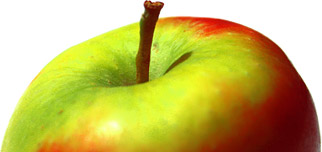Apple identification
We are often asked if we can help identify unknown apple varieties. Unfortunately apple identification is not usually possible by email. The taste and texture of the apple, as well as leaves and aspects of its provenance are all important in the identification process. However we have a sister website offering tools for online apple identitifcation.
The best way to get your apples identified is to take them along to a local apple festival, where there will often be an expert on hand. The local aspect is important because in the past gardeners tended to plant varieties that they knew about, and which were known to perform in the local climate. However apples vary considerably from one season to the next, and from one tree to the next - and indeed within the same tree depending on exposure to sunlight, so local identification is not always going to be accurate, although it is a good place to start. Remember also that in the past it was not unusual to grow apple trees from pips ("pippins") rather by grafting from known scion varieties, in which case identification is effectively impossible unless it was subsequently named and propagated (as happened with the famous Cox's Orange Pippin).
If local identification is not possible, some research stations offer an apple identification service, often for a nominal cost. If you live in the UK you can send samples to the National Fruit Collections for identification - see their website for more details.
When preparing samples, it is best to include 2-3 representative ripe apples, along with a new shoot with leaves. Remember to include details of the provenance and any local detail such as where the tree is growing, and what the tree looks like. Pack the samples in a strong box with insulation to prevent them being damaged - but make sure the packing material does not have any odours that could mask or taint the flavour of the fruit (e.g. do not use a box that has previously held soap or cleaning products).
If you know of other organisations that can carry out fruit identification please contact us.

